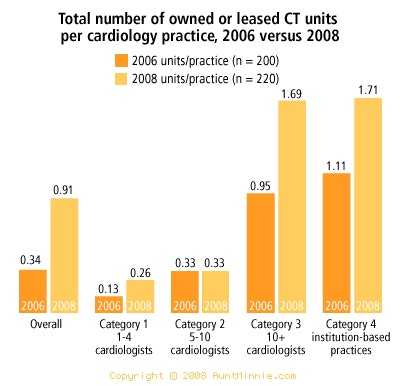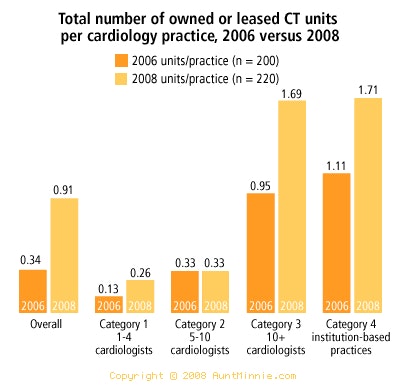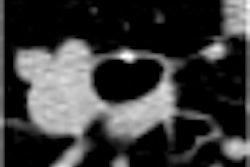
Cardiologists across the U.S. have been so enthralled with CT that they've tripled the modality's installed base of units within cardiology practices in the past two years, according to a new report scheduled for release this month by market research firm IMV Medical Information Division.
Even though data collection for the roughly 150-page report, culled from an online survey of 220 cardiologists and supplemental telephone interviews, was completed in September 2008, before the nation's economic woes publicly surfaced, cardiologists expressed some trepidation with their purchasing patterns and clinical practices, the study found.
Still recoiling from the Deficit Reduction Act of 2005, cardiologists tempered their enthusiasm for bringing additional diagnostic imaging modalities into their practices courtesy of simple economics, noted Mary Patton, director of market research at IMV of Des Plaines, IL.
Among the leading concerns cardiologists cited was "difficulty of obtaining reimbursement," Patton said. "This really has risen to the top as the big issue among cardiologists who are dealing with insufficient reimbursement and precertification requirements."
Cardiologists also expressed concern about new modalities "generating adequate patient volume" to justify investing in the equipment, Patton indicated, as well as ongoing operational costs in terms of service and staffing.
Not surprisingly, many cardiologists (73%) cited price as a key vendor selection criterion for investing in imaging equipment, according to the report, but that was balanced by the importance of working with state-of-the-art technology as indicated by an equivalent number (71%) of survey respondents.
The report highlights recent trends in cardiology referral and self-referral decisions and anticipated changes in cardiology procedures and equipment purchasing trends. It also details the use of specific diagnostic imaging modalities for certain cardiac indications, as well as purchasing trends for office-based diagnostic imaging equipment.
A sequel to IMV's initial study in 2006, the new report includes some 400 data points and explores the use of cardiac CT and CT angiography, CT calcium scoring, cardiac MR and MR angiography, SPECT and SPECT/CT, PET and PET/CT, cardiac catheterization, and echocardiography within private practices of varying sizes. Nearly 77% of cardiologist survey respondents hailed from metropolitan areas with populations that exceed 50,000.
IMV conducted the 30-minute online survey between July and September 2008. What's most noteworthy in the report, according to Patton, is the number of purchased and leased CT units installed as of summer 2008 compared with data two years earlier.
"Overall, one-third of cardiologists surveyed were adding CTs in 2006," she said. "It's grown to three times that in two years. It's an incredible growth rate in such a short time."
 |
In addition, the 2006 study found that 64-slice CT represented the most advanced model available at the time, but in the 2008 study it was the minimum level of technology.
"The majority of units out there in the cardiology practices are 64-slice units," Patton noted. "It's extraordinarily important to them to be state-of-the-art. With 64-slice CT, cardiologists want most of the picture taken within one heartbeat. It's got to be very fast for it to be worthwhile to them. For the large private cardiology practices, their perception is that there's no point in buying CT if not 64 slice."
Patton acknowledged she wasn't so surprised to find cardiologists buying CT, as she was to learn that they're primarily investing in 64-slice CTs, and that the adoption rate has been so rapid.
"Changes in installed bases tend to happen slowly," she noted. "This has happened unusually fast for such an expensive piece of equipment."
The study also showed that cardiologists favor new 64-slice units over refurbished models. "We found that there wasn't a great deal of interest in refurbished equipment when it came to 64-slice CTs," she said. "[Cardiologists] are really concerned about being the best. In general, they were more willing to consider refurbished units for the lower-end, more well-established modalities and bread-and-butter procedures." One example is echocardiography, she added.
IMV discovered some polarizing but not surprising results about referrals, with a clear delineation between referrals to others and self-referrals along logical lines. Regardless of modality, cardiologists tend to refer everything or nothing, Patton indicated. Those who are self-referring cases, by and large, have been adding equipment to their practices.
Cardiologists who self-refer were primarily motivated by two factors, according to Patton. They cited "better control for quality of imaging procedures" and "financial benefits to the practice" as equally important reasons for self-referred diagnostic imaging procedures. Other key reasons for self-referral were "faster and easier access to imaging services" and "easier on the patient."
By Rick Dana Barlow
AuntMinnie.com contributing writer
December 23, 2008
Disclosure notice: AuntMinnie.com is owned by IMV, Ltd.
Related Reading
IMV: Nuclear med procedures up in 2007, November 11, 2008
Radiation oncology procedure volume edges up, report states, August 28, 2008
MRI procedure growth rate slows, study shows, June 5, 2008
PET drives growth in nuclear medicine market, April 30, 2008
Nuclear medicine market nears $300 million, February 26, 2008
Copyright © 2008 AuntMinnie.com



















